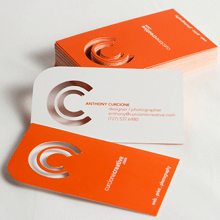When you own a small business, your business card is not only a networking tool but also an important visual reminder of your brand. So you need to make sure it’s working effectively for your business.
There is a fine line between having too much information and not enough on your business card design. You don’t want your business card design to seem cluttered and disorganised but at the same time it’s important to make sure that your contacts have everything they need in order to reach you.
What Are Business Cards?
In the simplest terms, a business card is a small piece of paper or card that displays your business contact information on it. But at Kwik Kopy, we know a great business card can mean so much more! Business cards are the easiest way to advertise your business and legitimise your brand. These small and convenient pocket-sized cards are the embodiment of a business handshake – with just a simple pass of a card, you can share your business to anyone who wants it.
What information should you include on your business card?
Business Name & Logo: Remember that your business card is an advertisement for your small business, not for you the individual, so ensure that the business name and logo is the main focal point of the design.
Name & Position: If you are responsible for a number of different aspects of the business, try to think about the people who will be receiving the card and the reasons they are most likely to be contacting you and decide on the most appropriate title from there.
Email Address: People are often more comfortable sending a quick email enquiry than picking up the phone to chat. This makes your email address a vital piece of contact information.
Phone Number: Although people often prefer email, including a phone number on your cards will add credibility. If you want your customers to be able to reach you anywhere, consider adding your business mobile number.
Website: Your website address is an essential addition that should not be overlooked!
Optional Extras: Information to add to your Business Card
Social Media Accounts: Where relevant, add your social media details, especially for brands that suit Instagram, Facebook, Youtube and Pinterest.
Skype Details, Wechat: If your business is set up to take calls (or videos) via Skype or WeChat it’s definitely worth adding these details in (particularly if you are doing business overseas).
Products and Services: If it isn’t instantly obvious what your company does, include it on your business card as a reminder to customers. We recommend lists or dot points to make it easier to read.
QR Codes: An optional extra is the QR code. It’s a great way to link people to more detail about your company.
Why Do You Need Business Cards?
Running a business is a full-time job, and whether or not you’re in the office, you need to be ready to showcase who you are and what you do. And one of the most important parts of keeping your business running is consistency.
The business card is your simple solution to make sure your message is the same wherever you are, whatever you are doing.
Whether you are at a formal event with potential partners, or in the middle of the street when you happen to run into an interested client, the business card ensures that the exact message and representation you want for your business is projected every single time.
When someone asks, “What do you do?” or, “What can you offer me?”, don’t waste your time stumbling about for an explanation. Simply let the card do the talking.
You never know where the next deal will take place.
Speak to the team at Kwik Kopy for advice about what can work best for your business card. We can provide further information on powerful and effective business card design.






